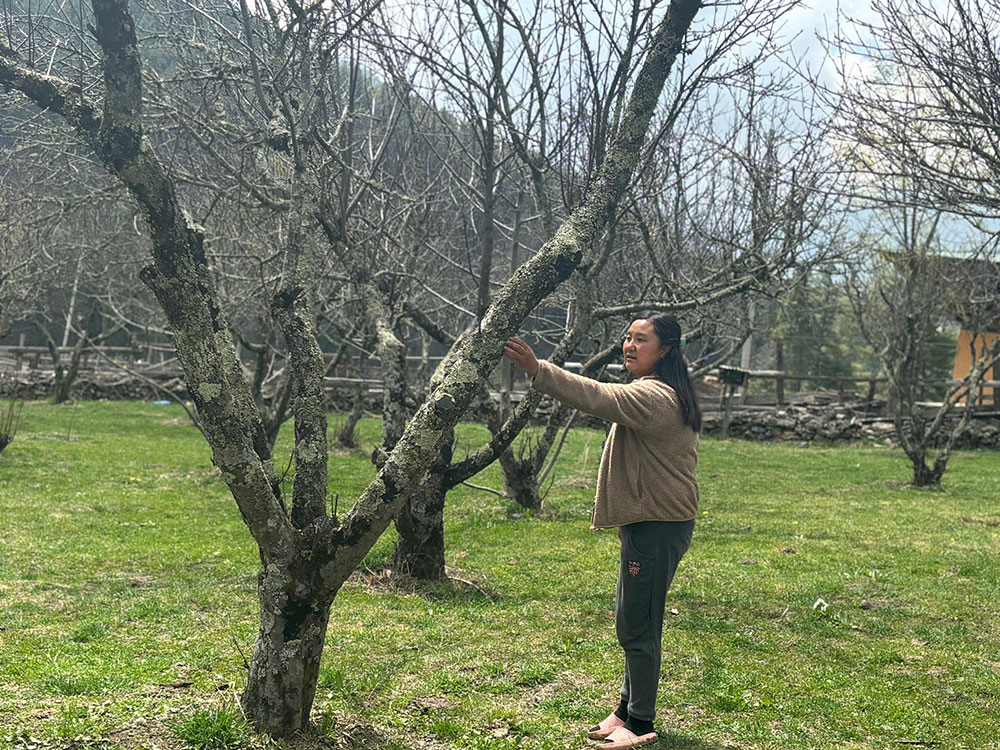New crops fail to thrive as fading apple holds sway
Dechen Dolkar
At about 2,500-metres above the sea level in Haa, a quiet but painful struggle between sentiments and change is taking place, and at the core of it is apples – a source of good cash income not long ago.
The government’s efforts to persuade apple farmers to switch to higher-earning crops such as walnuts and almonds is seeing some resistance, even as farmers of all ages watch their apples wither before their eyes.
Despite the challenges posed by warmer weather and rampant afflictions like pests and diseases, farmers in Haa, Paro, and Thimphu cling to their apple trees. For them, these orchards are not just sources of income but as ancestral heritage and deep sentiment.

Only a few new high-end fruit trees grown in Haa
Tshering Yangdon, 28, from Garina village recalls owning about a 100 apple trees in her parent’s orchard. She can barely count 20 today. When I was young, the colour of the apple was red but now it is fading. During my parents’ time, they earned about Nu 100,000 and gradually the price has decreased,” she said.
The two apple-growing gewogs of Uesu and Katsho in Haa lie at altitudes well over 2,500 masl going up to 2,700 masl. The apple orchards of Haa are optimally suited for the production of good-quality apples. Cooler conditions are also a precursor for diseases such as scab and rust that require multiple and timely sprays. Moreover, apples grown at higher altitudes tend to be small in size while the brix content is lower.
Yet Tshering Yangdon points out that people have gained trust in the apple over decades and that many were not growing other fruit trees.
She tried to switch to the new high-end crops with the support of the authorities and planted a few avocado, walnut and almond trees. But new crops can present new issues. She said farmers cannot harvest walnuts, as the birds eat them all.
She said that if farmers can manage their apple orchards, the traditional fruit can still fetch a good price. “We can also preserve our apples and they can fetch a good price in winter.” Older farmers echo her sentiments. Yes, they are growing fewer apple trees than their parents, as they see climate change impact apple trees with pests and diseases.
Gyelmo, 40, Uesu gewog of Haa said that she once had more than 100 trees. The number has halved today. She has planted a few avocado, walnut, plums and almond trees after officials from Yusipang said that they would bear 80 percent of the cost. “I still want to plant apples,” she said.
Jechu, 67, a farmer of Lungnyi gewog in Paro, tends to over 300 apple trees planted three decades ago. Last year, he earned about Nu 170,000 from his orchard. While some of his trees are drying and yielding poor fruit, Jechu remains sceptical about transitioning to higher-yield new fruits. He maintains only one or two walnut, pear, and persimmon trees for personal consumption.
He said that he is also replacing old apple trees with new apple saplings. “Apple has been our main source of income for our family for decades.”
Chimi Lham, a 55-year-old from Uesu gewog in Haa, fondly recalls the prosperous years when apples brought between Nu 70,000 and Nu 90,000 during peak production periods. However, declining yields and market challenges now overshadow the once profitable enterprise. The apple trees were planted 40 years ago.
She said that the unique market dynamics of apples compared to other fruits, where customers come directly to the farm to pick their produce, ease the burden on farmers. “We requested agriculture officials to give new apple saplings, but they discouraged us from planting apple trees.”
The National Focal Officer of Fruits and Nuts Programme, Department of Agriculture, Sangay Dendup said that the department is trying to rehabilitate apple orchards where the apple trees are drying or giving poor yield.
“The department will provide new apple seedlings, especially in Bumthang Haa, and introduce high altitude apples for places above 3,000 masl ” he said, adding that the department will also provide high-end fruits like kiwi, walnut and almond in apple growing places. Almonds and walnuts fetch good prices and can be preserved for a year.
He said the apple trees in the country are 40 to 50 years old now and it is evident that apple trees will dry since they are very old. “It is high time farmers diversify. They should adapt to new varieties of crops,” he said.
Apple trees are drying, Sangay said, because of poor orchard management. All apple orchards in the country are fed, and never irrigated four times in a year, as required. In some places, urbanisation has forced people to abandon growing apples. There are no rules and regulations that say orchards should be protected.
Sangay Dendup said that incidences of pests and diseases increased and attributed it to climate change. Prolonged droughts and hail stone during spring or flowering season affect the production and quality, he said. Poor or no snow in winter for years also affected the quality of apples. A certain chilling temperature is required to keep soil and roots moist.
The National Plant Protection Centre (NPPC) has conducted research in Haa to see why apple trees are dying or yielding poor fruits. According to the preliminary research, apple orchards of Haa are not optimally suited for the production of good quality apple fruits.
The cooler conditions are also attributed to diseases that require multiple and timely sprays. The report also states that since this field visit was made during the end of the season when the trees are at their natural senescence stage, it is recommended that a second visit be made during flowering and fruit setting time.

This story is supported by Bhutan Media Foundation under GEF-Small Grants Programme of the UNDP


